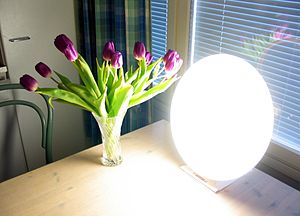| English: A 30 kHz bright light therapy lamp (Innosol Rondo) used to treat seasonal affective disorder. (Photo credit: Wikipedia) |
2012 Winter Solstice will occur on December 21
Many people pay very little attention to when the winter season begins each year. To them it is just another day on the calendar; however, for at least 15% of the United States population this seasonal change brings on problematic changes commonly referred to as seasonal affective disorder or SAD.
A brief history of SAD
It was in 1984 when Dr. Norman E. Rosenthal, a psychiatrist and scientist, working with colleagues at the National Institute of Mental Health described and named seasonal affective disorder (SAD). SAD is considered a mood disorder experienced by people who have normal mental health throughout the year, but experience depressive symptoms in the winter, summer, spring or autumn of each year. Rosenthal’s research was prompted by the depression he himself experienced while working in the winter months in the northern part of the United States.
The Diagnostic and Statistical manual of Mental Disorders (DSM-IV) does not classify SAD as a unique mood disorder, but as a “specifier of major depression.”
Dr. Charles Raison discusses SAD
Charles Raison, MD, is an Associate Professor of Psychiatry and Family & Consumer Science in the Department of Psychiatry at the University of Arizona. Dr. Raison is also CNNHealth‘s mental health expert and this week he wrote an interesting article “When it’s more than ‘winter blues'” talking about his own life experience and how to deal with SAD. We hope you read the whole article, but here are few of his observations:
- Symptoms usually start in the fall as the days shorten. Interestingly, for most people feeling depressed is not what comes first. Rather, people tend to become tired, to sleep more and to eat more — especially carbohydrates — and to gain weight as a result.
- They have increasing difficulty getting up in the morning and remaining interested in the things around them. Their ability to remember things and to concentrate diminishes. Only as winter bears down in earnest do sadness, despair and other classic emotional symptoms of depression take hold.
- Like all psychiatric conditions, SAD occurs at the intersection of genes and environment, of nature and nurture. This point has been brought home by several remarkable studies showing that people in Iceland have remarkably low rates of SAD, despite living in one of the darkest winter environments on earth.
- Although far less common than winter depression, summer-type SAD is a well-recognized condition. Unlike winter depression, summer depression is all about heat. The hotter it is, the more likely people are to become depressed.
- I don’t recommend starting any type of medical treatment without first talking with your doctor.
A report on SAD from CBS KTVA in Anchorage, Alaska
If you are having trouble viewing this video, you can see it here.
SAD known by many other names
If you are first learning about seasonal affective disorder, it could be that you and your loved ones have never experienced it OR maybe you are more familiar with vernacular names or phrases often used to describe SAD. Take for example: the winter blues, winter doldrums, winter depression, summer blues or even June gloom (also a common name for a weather pattern in Southern California). If you have lived in the colder and more northern states of the United States, then perhaps you have noticed that communities promote many winter festivals and outdoor events. While these events often are purposely driven as business generating and vehicles for charitable fundraising, you might find it interesting that many winter events have their roots in trying to keep people’s spirits high through the long winter months.
One of the most famous of these winter festivals is Anchorage’s Fur Rendezvous. In 2012, Fur Rendezvous was selected as the number one winter carnival in the world by the National Geographic Traveler. According to Wikipedia:
In 1935, Anchorage had a population of only about 3,000 and was very isolated, so to bring the community together and lift spirits, resident Vern Johnson organized a three-day sports tournament, called the Winter Sports Carnival, timed to coincide with the rendezvous, which brought increased activity. As the fur trade was then the second-largest industry in Alaska, folding it into the event seemed natural, and it was renamed the Winter Sports Tournament and Fur Rendezvous from 1937, and later just Fur Rendezvous.









